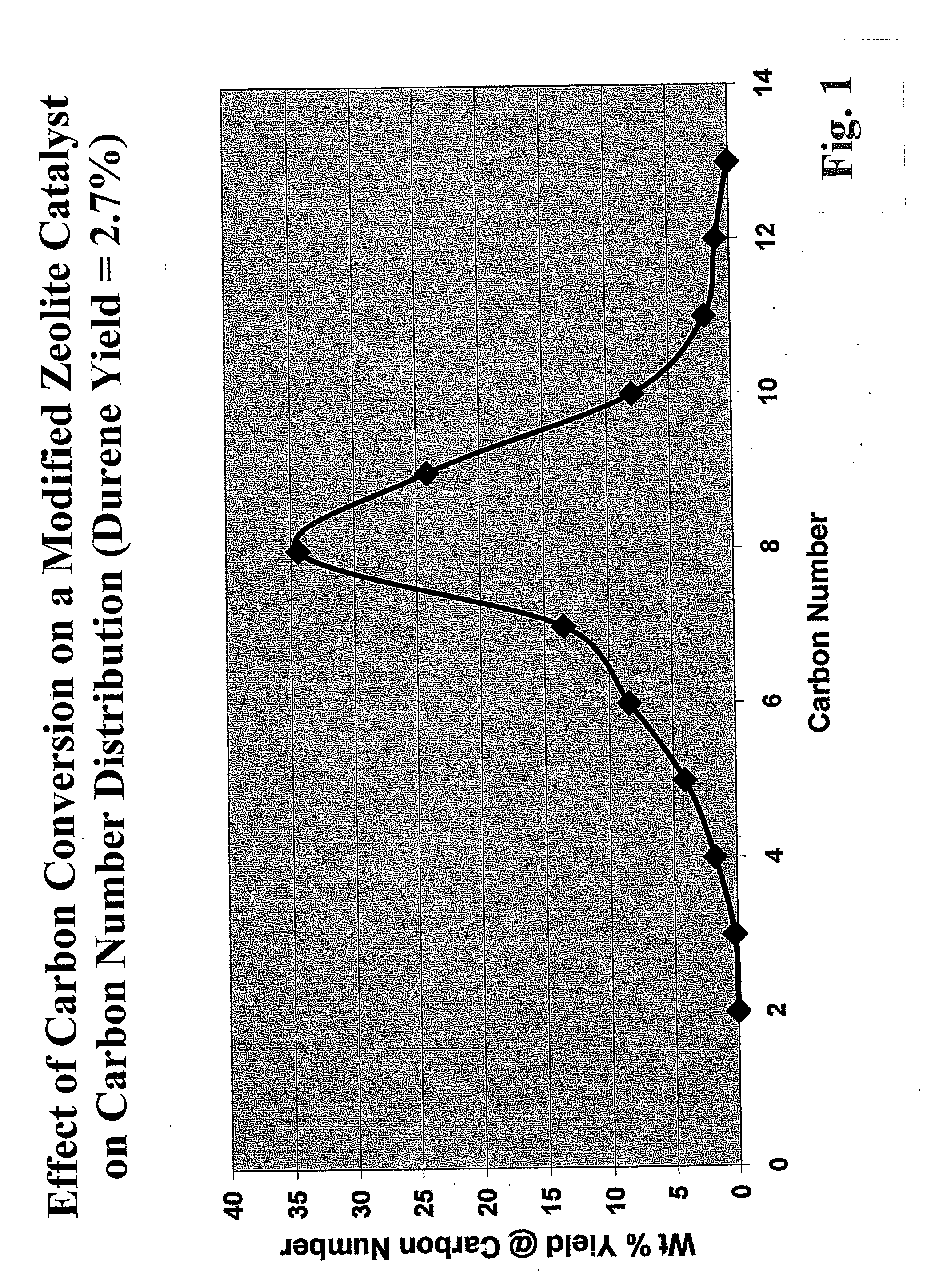Process for converting an oxygenated feed to high octane gasoline
a technology of oxygenated feed and gasoline, which is applied in the direction of hydrocarbon oil treatment products, fuels, physical/chemical process catalysts, etc., can solve the problems of reducing the gasoline yield, and essentially non-existent infrastructure and markets
- Summary
- Abstract
- Description
- Claims
- Application Information
AI Technical Summary
Benefits of technology
Problems solved by technology
Method used
Image
Examples
example 1
[0045]A ZSM-5 zeolite catalyst was obtained from Sud Chemie (T-4480) and was modified by incipient wetness impregnation with a 30% phosphoric solution and calcined for 4 hours at 500° C. The modified catalyst was placed in a fixed bed reactor installed in a three zone electrically heated furnace and DME was delivered at 350 C and 15 psig at a rate of 9.9 grams per gram of catalyst per hour. Liquid DME gas is supplied to the reactor system using an ISCO HPLC pump where the pump's piston pushes the liquid DME through a back pressure regulator and into reactor system. Online product sampling analyzes the entire hydrocarbon product distribution from methane on out to C15 or more using a running on a Wasson Analytical modified Agilent 6890 GC. Following this gas chromatograph, the condensable hydrocarbons are trapped by a condenser which is operated at −3° C. Following the condenser, the non permanent gasses and light hydrocarbons are analyzed by a refinery gas analyzer. The condensed hy...
example 2
[0048]98 grams of ZSM-5 were impregnated with 27.73824 grams of tetraethylorthosilicate, dried in a drying oven at 120° C. and calcined for 4 hours at 500° C. 7.2 grams of the resulting catalyst was mixed with 70 grams of inert alundum and placed in the reactor system described previously. Dimethyl ether was passed over this catalyst at a rate of 1.63 liquid cc's per minute along with 250 cc / min nitrogen gas at 15 psig and 350° C. inlet temperature. The product went to a condenser held at −3° C. where the C5+ hydrocarbons were condensed out. The remaining gas was analyzed using a gas chromatograph gas analyzer.
[0049]The condensed liquid product had an aqueous phase and a hydrocarbon liquid phase floating on top of the aqueous phase. The hydrocarbon phase was submitted for detailed hydrocarbon analysis.
[0050]A carbon number distribution was also done on the sample and the following results were obtained as shown in Table C below:
TABLE CC#% Weight% VolumeC20.0030.006C30.2240.362C41.68...
example 3
[0052]Mo / ZSM-5 catalysts with Mo loading ranging from 0.01% to 20% were prepared by incipient wetness impregnation of NH4ZSM-5, HZSM-5 or alumina- or silica-bonded ZSM-5 having a SiO2 / Al2O3 between 20 to 800 with an aqueous solution of (NH4)6Mo7O24.4H2O (AHM). The impregnated samples were dried at 383K and finally calcined at 573K to 1073K for several hours. Catalytic reaction for methanol / dimethylether conversion to gasoline was carried out in a fixed-bed continuous-flow reactor at 573K to 773K temperature and 0 Psig to 1000 Psig pressure. The methanol weight hourly space velocity was varied from 0.1 hr-1 to 10.0 hr−1.
[0053]Sample 1: A commercial catalyst T4480 (HZSM-5 with 30 wt. % Al2O3 binder) was used for methanol conversion at 300° C. and 350 psig at a methanol weight hourly space velocity (WMeoHHSV) OF 4.5H-1 using nitrogen (200 Ml / min) as carrier gas. The obtained gasoline has a durene concentration of 20.5%.
[0054]Sample 2: 0.75 g AHM was dissolved in 20 mL deionized water, ...
PUM
| Property | Measurement | Unit |
|---|---|---|
| temperature | aaaaa | aaaaa |
| temperature | aaaaa | aaaaa |
| temperature | aaaaa | aaaaa |
Abstract
Description
Claims
Application Information
 Login to View More
Login to View More - R&D
- Intellectual Property
- Life Sciences
- Materials
- Tech Scout
- Unparalleled Data Quality
- Higher Quality Content
- 60% Fewer Hallucinations
Browse by: Latest US Patents, China's latest patents, Technical Efficacy Thesaurus, Application Domain, Technology Topic, Popular Technical Reports.
© 2025 PatSnap. All rights reserved.Legal|Privacy policy|Modern Slavery Act Transparency Statement|Sitemap|About US| Contact US: help@patsnap.com

